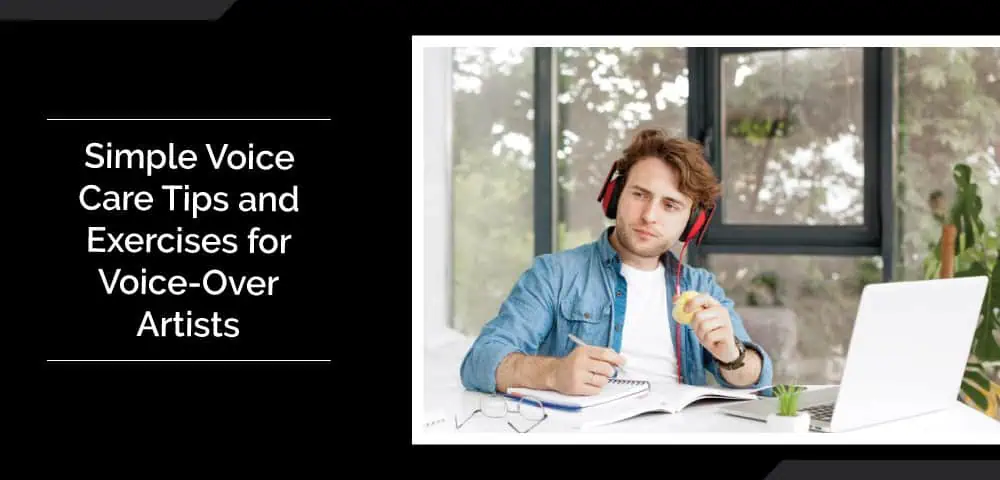
10 Common Mistakes Beginner Voice-Over Artists Should Avoid
May 28, 2025
Role of Voice Clarity: Why It Is Important in IVR Systems
August 4, 2025For a voiceover artist, the top priority is ensuring their voice performs at its best, without strain, weakness, or interruptions. But it is not as easy as we think. To get a sustaining voice and deliver a captivating voice that hooks the audience requires a lot of consistent effort in the backend. If you want to build a professional voice that captivates both your audience and clients, be sure to incorporate the simple voice care tips and exercises shared in this blog into your daily routine and watch your voice elevate to the next level. Contents
A] Why Voice Care Matters for Voice-Over Artists?
Vocal strain and poor habits can impair voice quality and lead to serious issues such as vocal fatigue, nodules, or laryngitis. A voiceover artist may struggle to maintain their livelihood if they develop any of these vocal cord problems. Therefore, every voice-over actor should follow the voice care regimen to ensure their vocal organs are performing at an optimum level. In addition, when it comes to sustaining a long-term voice-over career, voice care is paramount for voice-over actors, regardless of their experience level. So, why not learn voice care tips for voice-over actors?
B] How to Keep Your Voice Healthy for Voice-Overs
1. Stay Hydrated Throughout The Day
Staying hydrated is crucial when recording, as it prevents your vocal cords from drying out, keeping your voice smooth throughout the recording. So, to keep the vocal cords lubricated and moist, ensure you stay hydrated.
2. Avoid Caffeine, Smoking, And Alcohol Before Recordings
Caffeine, smoking, and alcohol negatively impact vocal cords by causing dehydration, inflammation, and irritation, which ultimately leads to hoarseness, vocal cord damage, or even cancer. Therefore, every voice actor must refrain from consuming these substances to ensure their voice instruments are in line throughout their career.
3. Get Enough Sleep And Rest Your Voice Between Sessions
Getting enough sleep and resting your voice between sessions is crucial for maintaining vocal health and overall performance. Every voice actor should ensure they get at least eight hours of sleep and take enough breaks between sessions to give their voice organs the needed rest.
4. Use A Humidifier In Dry Environments
A humidifier keeps your vocal cords and surrounding tissue hydrated and lubricated in a dry environment. Therefore, always ensure you have a humidifier running to keep your voice performance optimum and smooth.
C] Voice Care Routine for Professional Voice Artists
- Morning Hydration (Warm Water, Herbal Tea): Start your day with morning hydration, which includes warm water and herbal tea. Doing so prevents dryness, irritation, and potential strains on vocal folds.
- Gentle Vocal Warm-Ups Before Recording: Gentle vocal warm-ups before recording relax the vocal cords and supporting muscles. It should include exercises like lip trills, humming, and vocalisations on easy vowels.
- Cooling Down The Voice After Intense Sessions: Every voice artist should prioritise vocal rest by incorporating gentle cooling exercises, like humming or lip flutters. Also, staying hydrated is equally important to prevent dryness and inflammation. Performing these cooling-down regimens helps their voices recover and relax.
- Regular Check-Ups With An ENT: Apart from daily voice care routines, voice artists should also schedule visits to an ENT (Ear, Nose, Throat) specialist to regularly check on their voice organs’ conditions. This proactive measure allows them to diagnose any potential conditions beforehand.
D] Breathing Exercises for Voice Over Artists
1. Diaphragmatic Breathing
Diaphragmatic breathing, also known as belly breathing, is a vital voice exercise for voice-over artists. It significantly improves lung capacity, provides control over the voice, and supports the vocal organs. To perform diaphragmatic breathing, place a hand on the chest and another on the belly, and inhale through the nose slowly, deeply, and fully. Now, exhale slowly through pursed lips while contracting the belly.
2. “S” And “Z” Sustained Sounds For Control
This exercise develops breath control and vocal endurance. Start by taking a deep diaphragmatic breath. Then, exhale slowly while making a soft, sustained “S” sound like a gentle hiss. Aim for a steady and consistent airflow. Repeat the same with a “Z” sound, which adds vocal cord engagement. Try to lengthen the duration of each sound over time, building your control and breath-holding capacity, which is useful for long recording sessions.
3. Box Breathing (4-4-4-4 Method) For Relaxation And Breath Support
Box breathing is a simple yet powerful technique to calm the nervous system and strengthen breath support. Inhale through the nose for 4 seconds, hold the breath for 4 seconds, exhale through the mouth for 4 seconds, and then hold the exhale for 4 seconds. Repeat the cycle for several minutes. This helps reduce anxiety before recording, improves focus, and trains your body to regulate airflow smoothly and consistently.
E] Daily Vocal Exercises for Voice Artists
1. Lip Trills And Tongue Trills
These are excellent for gently activating the vocal cords and improving breath control. Simply blow air through closed lips or a fluttering tongue while producing sound. This reduces vocal tension and helps with resonance and airflow.
2. Humming Scales To Wake Up The Vocal Cords
Humming is a low-impact warm-up that stimulates the vocal cords without strain. Start by gently humming a five-note scale, gradually increasing your range. It promotes resonance and vocal fold vibration while keeping the throat relaxed.
3. Pitch Glides (Sirens) To Stretch Vocal Range
Sirens involve sliding your voice from low to high and back again in one smooth motion, like the sound of a siren. This stretches the vocal cords, improves vocal agility, and expands range, which is vital for character work and expressive readings.
4. Articulation Drills
Tongue twisters like “Red leather, yellow leather” or “Unique New York” help sharpen enunciation and diction. Repeat them slowly, then gradually speed up to enhance clarity and speech precision.
Also Read: Top Sectors That Rely on Professional Voice-Over Services
Conclusion
So, here we are. We have explored daily vocal exercises for voice artists to enhance the voice quality while safeguarding vocal organs from any potential damage. Voice artists should perform these suggested voice exercises with consistency to maintain voice clarity, flexibility, and endurance. Doing these exercises with the best of your ability will ensure you have a voice in top shape.
If you are looking for an expert voice-over artist in Mumbai, look no further and choose Peter Abraham with your eyes closed. He has provided voiceover services to industry leaders like Amazon, Airtel, BBC, TATA, and Lenovo, among others. Contact him today for cost-effective and captivating audio production, and watch your business roll with his engaging voice!

Peter Abraham
Peter Abraham is a versatile voice-over artist based in Mumbai working in the voiceover industry since 2009. With a passion for storytelling and meticulous attention to detail in every project, he brings scripts to life with his captivating voice and professional delivery, exceeding client expectations. Whether it's a commercial or an audiobook, Peter specializes in a wide range of voice-over work, ensuring the highest quality.




